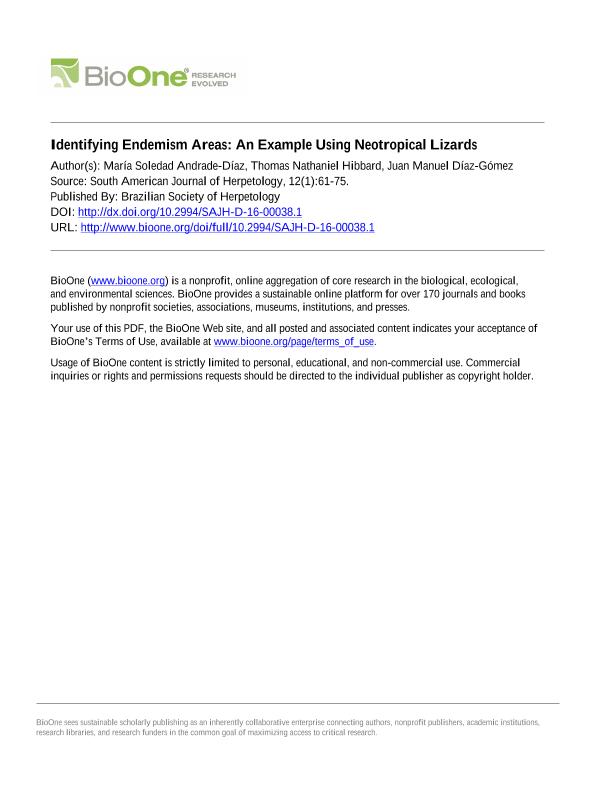Artículo
Las áreas de endemismo son centrales en biogeografía. Estas áreas son las unidades de estudio de los métodos biogeográficos analíticos y también son un criterio relevante para identificar áreas para conservación. La familia Liolaemidae es uno de los grupos más diversos en cuanto a riqueza de especies y ambientes. Durante la última década, el número de nuevas especies registradas para los géneros Liolaemus y Phymaturus aumentó exponencialmente. La mayoría de estas especies presentan distribuciones restringidas, baja densidad poblacional y alto riesgo de extinción. Estas características hacen de la familia Liolaemidae, especialmente el género Phymaturus, un constituyente fundamental de los ecosistemas que habita. Además, las especies de Liolaemidae fueron reconocidas como endémicas, pero este reconocimiento fue mayormente intuitivo y considerando el término “endémicas” como “con distribuciones restringidas”. En este trabajo presentamos información metodológica confirmando el alto grado de endemismo de las especies de Lioelaemus y Phymaturus, entendiendo endémico como “con distribuciones congruentes”. Los objetivos de este trabajo son: analizar los datos de distribución de 289 especies de la familia Liolaemidae e dentificar áreas de endemismo utilizando el programa NDM/VNDM. Con un tamaño de grilla 0.5° × 0.5°; identificamos 27 áreas de consenso y 118 especies endémicas (41,11%). Las áreas de endemismo presentaron patrones de grupos taxonómicos de especies repetidos. También recuperamos áreas de endemismo con diferentes tamaños de grilla, definidas por las mismas especies endémicas. Según la hipótesis de la biogeografía de la vicarianza, barreras (físicas o ecológicas) fragmentaron la distribución ancestral de los taxa. Por lo tanto, las áreas de endemismo propuestas en este estudio pueden ser resultado de eventos históricos que fragmentaron la distribución ancestral de la familia dando lugar a los patrones de distribución actuales. La identificación de patrones biogeográficos de las especies, nos permite entender el ecosistema desde una perspectiva histórica y generar información importante para su conservación. En este sentido, las áreas de endemismo de una familia pueden ser una herramienta relevante a la hora de identificar prioridades para la conservación de la biodiversidad. Areas of endemism are central to biogeography. They are used as study units by analytical biogeographic methods and as a criterion to identify areas for conservation. Liolaemidae is one of the most diverse groups of lizards in terms of species richness and environmental diversity. Over the last decade, the number of new species recorded for the genera Liolaemus and Phymaturus has increased exponentially. Most of them have restricted distributions, low population density, and high extinction risk. These features make this family one of the main environmental components of the ecosystems they inhabit. Furthermore, it has been long recognized that Liolaemidae species, especially within Phymaturus, are endemic, but that recognition was made intuitively and mostly equating endemic with "having a restricted distribution." In this study, we provide methodological confirmation of the high degree of endemism of the species of Liolaemus and Phymaturus, with endemic species defined as those "having congruent distributions." Our goals are to analyze the distribution data of 289 species of Liolaemidae and identify areas of endemism using the software NDM/VNDM. With cells of 0.5° × 0.5°, we identified 27 consensus areas and recovered 118 endemic species (41.11%). These endemic areas presented patterns of repeated taxonomic groups. We also found that some areas of endemism were recovered with different cell sizes, defined by almost the same endemic species. According to the hypothesis of vicariance biogeography, barriers (physical or ecological) fragmented ancestral distributions of taxa. Therefore, the areas of endemism proposed in this study might have been the result of historical events that fragmented the ancestral distribution of the family, giving rise to present day distribution patterns. The identification of biogeographic patterns enables us to understand ecosystems from a historical perspective and generate important information for their conservation. As such, the areas of endemism of a family can be an important and relevant tool to assess priorities for conservation of biodiversity.
Identifying Endemism Areas: An Example Using Neotropical Lizards
Fecha de publicación:
04/2017
Editorial:
Sociedade Brasileira de Herpetologia
Revista:
South American Journal of Herpetology
ISSN:
1808-9798
e-ISSN:
1937-2418
Idioma:
Inglés
Tipo de recurso:
Artículo publicado
Clasificación temática:
Resumen
Palabras clave:
Biogeography
,
Liolaemidae
,
Patterns
,
Reptiles
Archivos asociados
Licencia
Identificadores
Colecciones
Articulos(IBIGEO)
Articulos de INST.DE BIO Y GEOCIENCIAS DEL NOA
Articulos de INST.DE BIO Y GEOCIENCIAS DEL NOA
Citación
Andrade Díaz, Soledad María; Hibbard, Thomas Nathaniel; Diaz Gomez, Juan Manuel; Identifying Endemism Areas: An Example Using Neotropical Lizards; Sociedade Brasileira de Herpetologia; South American Journal of Herpetology; 12; 1; 4-2017; 61-75
Compartir
Altmétricas




